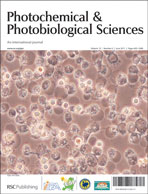Photodynamic therapy (PDT) is of increasing interest as a relevant treatment for human urinary bladder cancer. In the present experiments, the rat bladder transitional carcinoma cell line AY-27 was used as a model to study cell destruction mechanisms induced by PDT. Red LED light (630 nm) PDT with hexylaminolevulinate (HAL) as precursor for the photosensitizer protoporphyrin IX (PpIX) was used in treatment of the cells. Flow cytometry with fluorescent markers annexin V, propidium iodide and YO-PRO-1, as well as MTT assay and confocal microscopy, were used to map cell inactivation after PDT. Dark toxicity of HAL alone was low in these procedures and LD50 (24 h, MTT assay) was approximately 1.6 J cm−2 for standard red light (LED) irradiation (36 mW cm−2). Measurements done 1 h after HAL-PDT showed a maximum apoptotic level of about 10% at 6 J cm−2, however the dominating mode of cell death was necrosis. Forward light scattering indicated an increase in cell size at low doses, possibly due to necrosis. Survival curves had a dual-slope shape, a fit to single hit, multi-target approximation gave a parameter estimate of n = 10 and D0 about 2.6 J cm−2. Replacing continuous light with fractionated light delivery (45 s light/60 s darkness) did not affect the treatment outcome.

You have access to this article
 Please wait while we load your content...
Something went wrong. Try again?
Please wait while we load your content...
Something went wrong. Try again?


 Please wait while we load your content...
Please wait while we load your content...